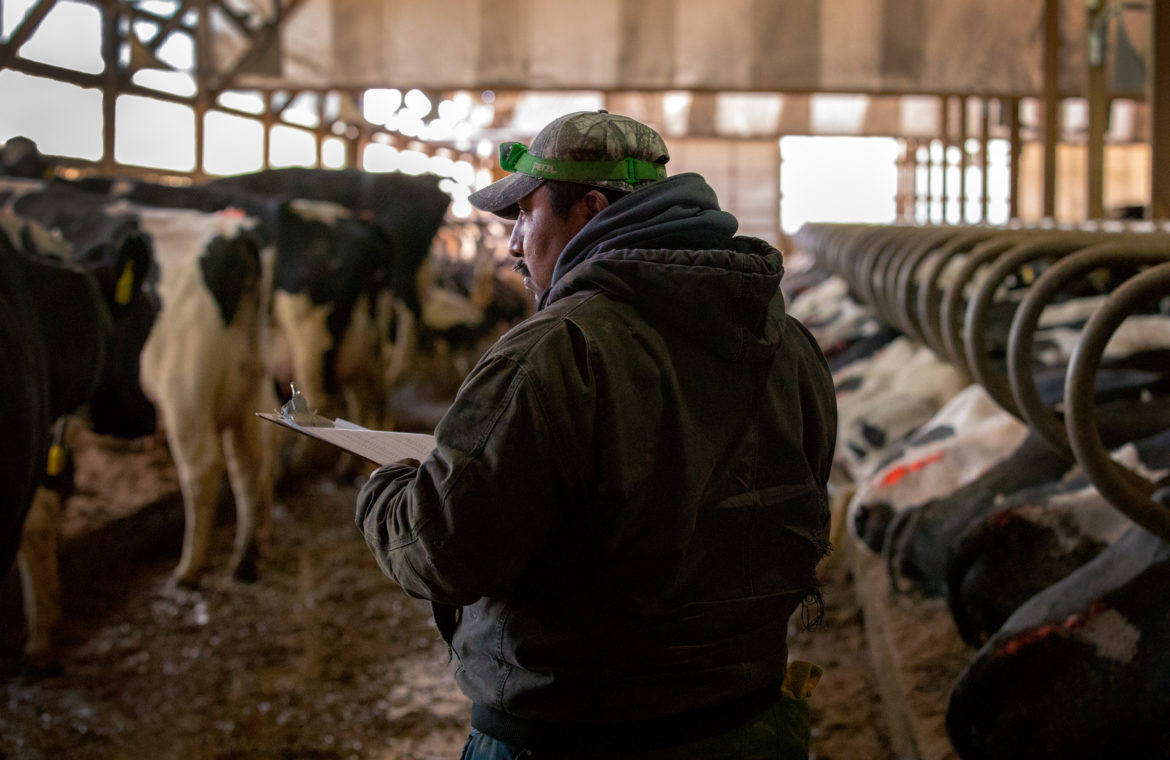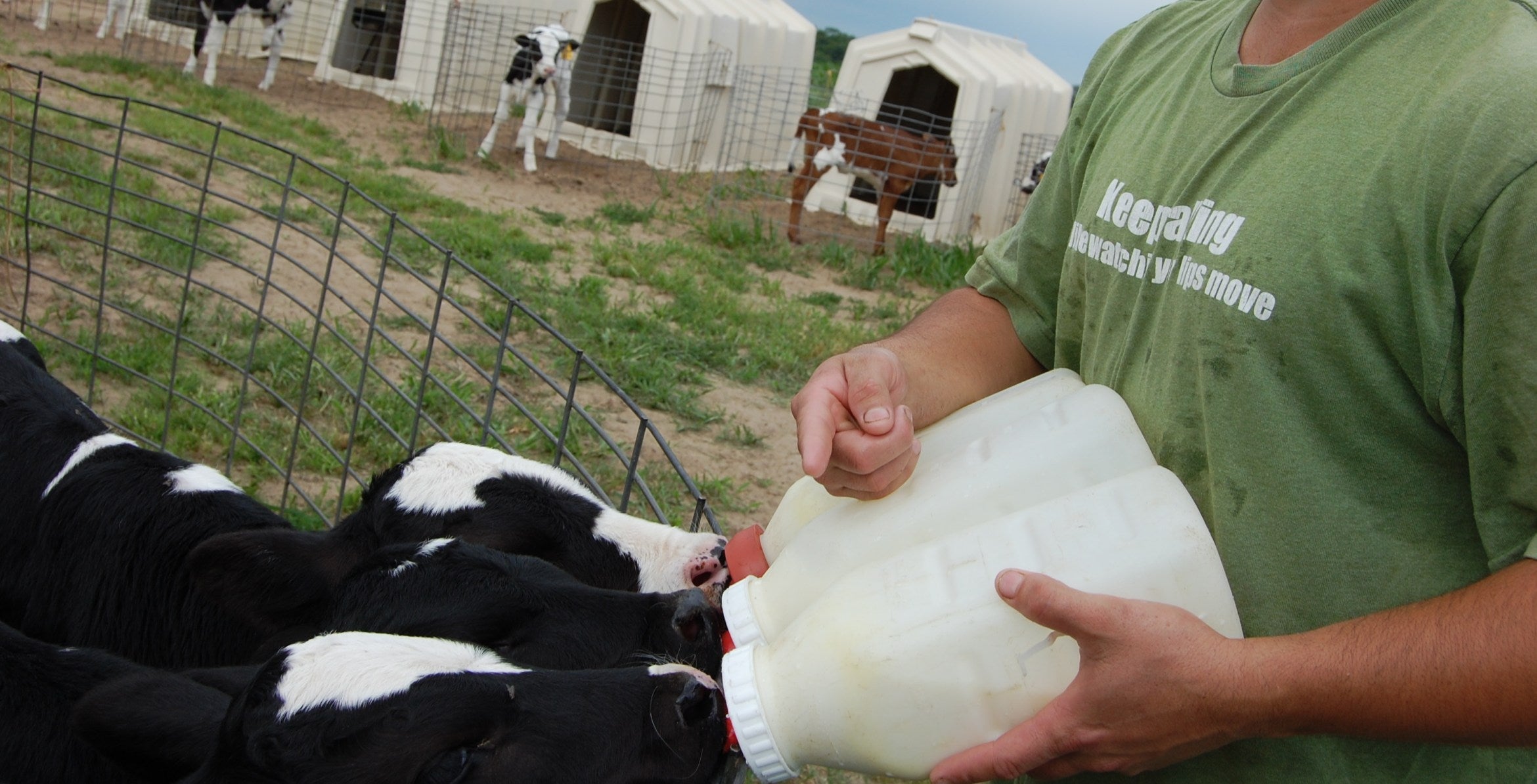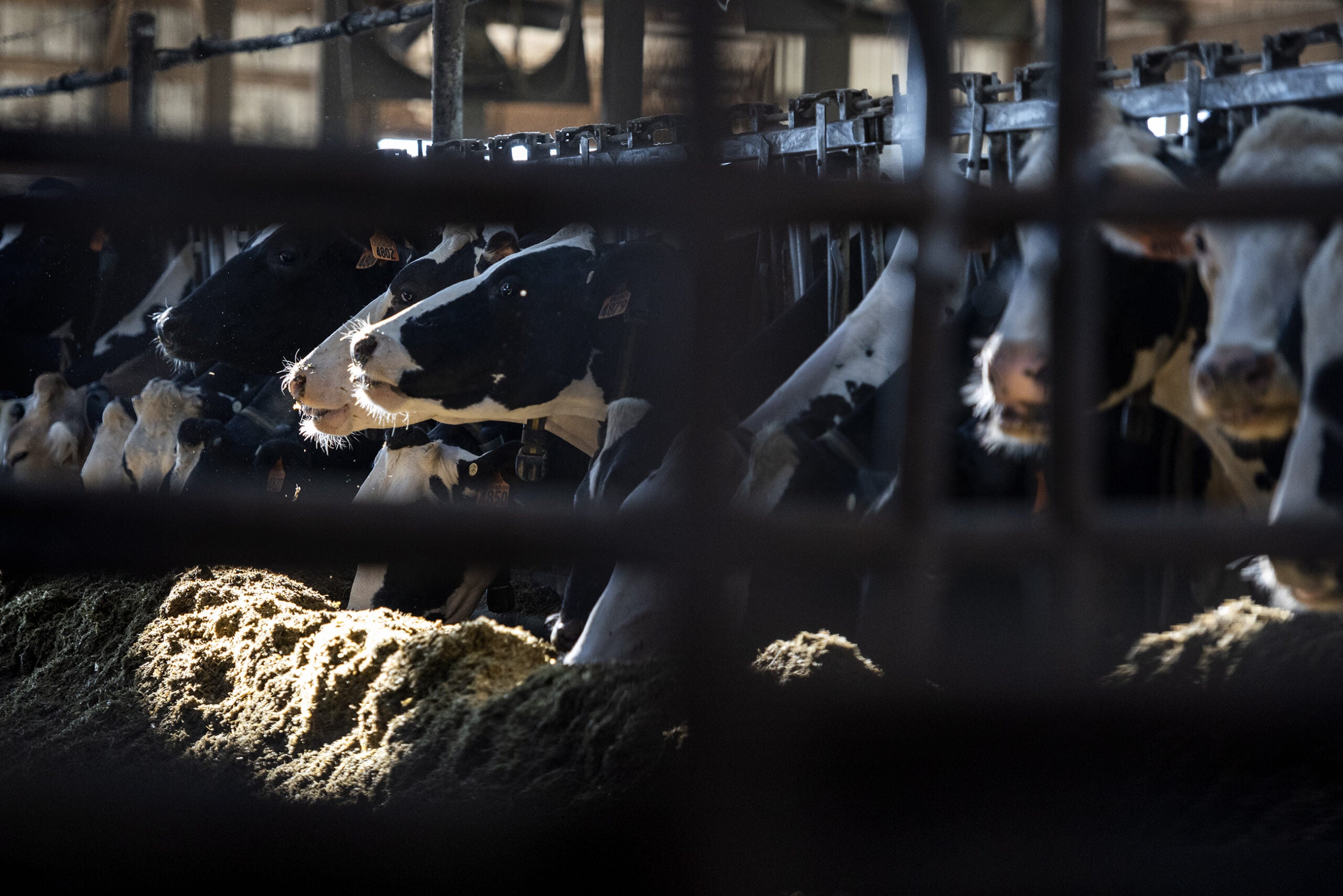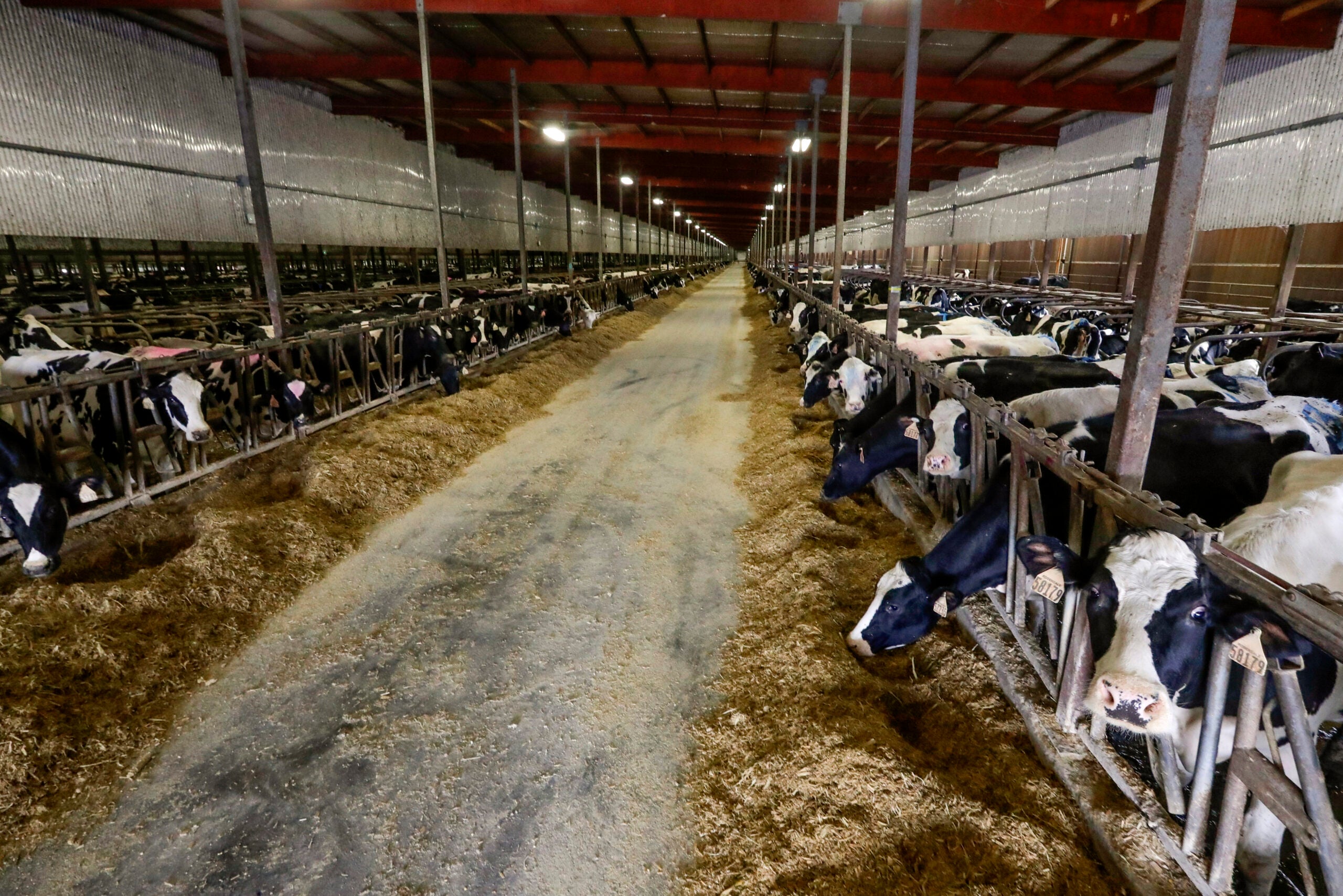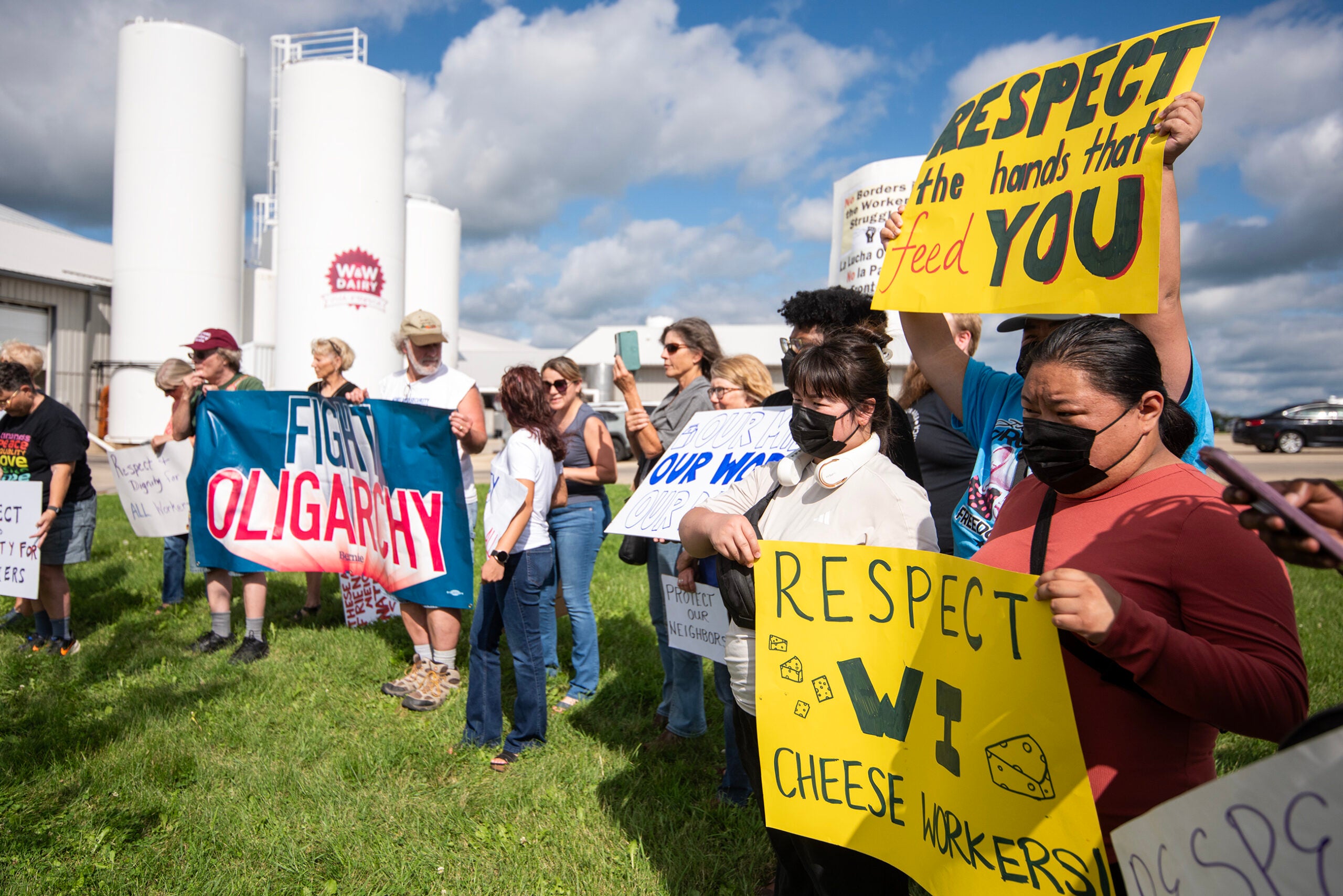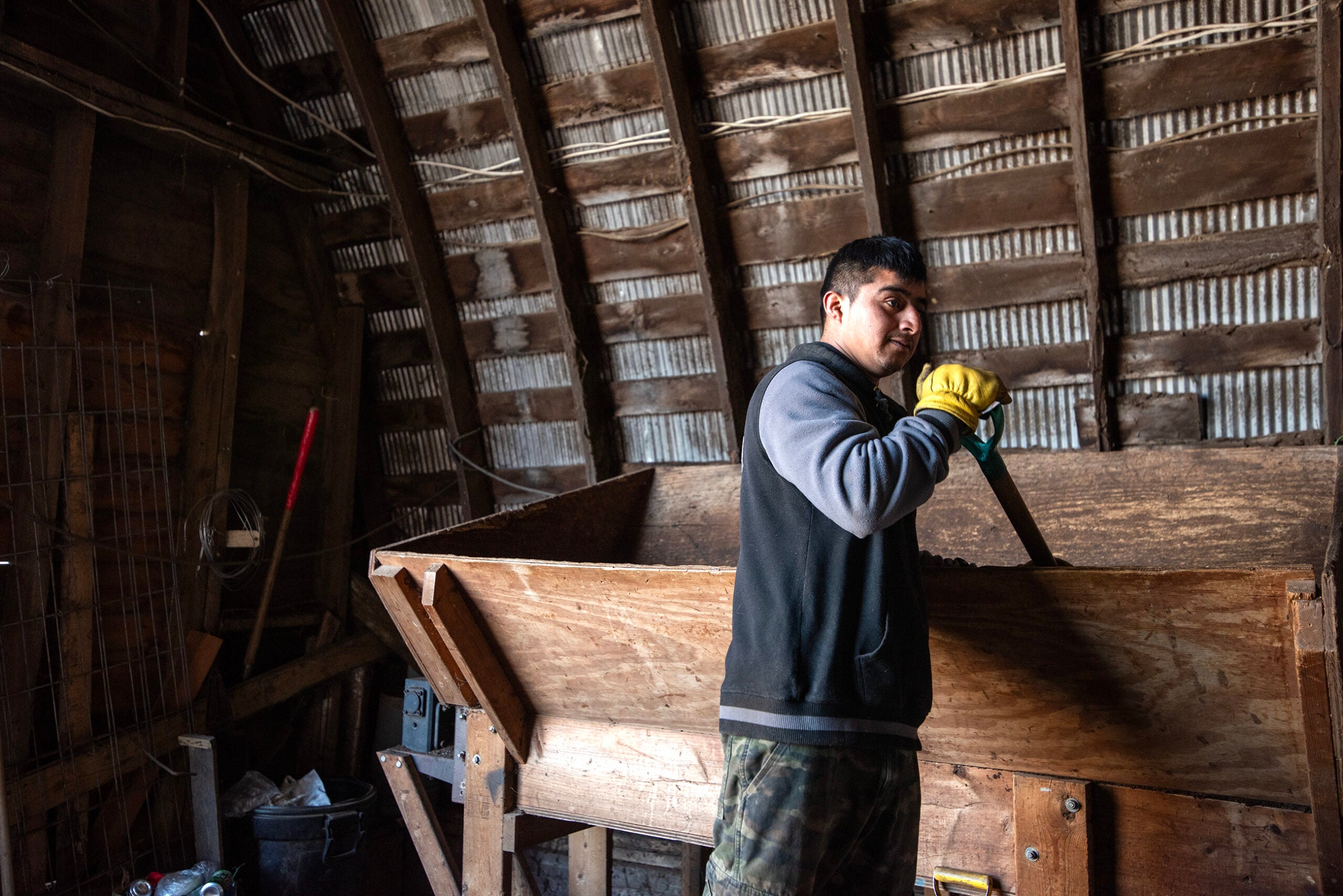Twenty-six-year-old Rosa Jiménez and her husband, Manuel, 36, used to do the grocery shopping together. They would take the kids and make a day of it. But, lately, Manuel goes alone.
“Imagine if they (immigration authorities) picked us up there. I won’t take the risk of them taking my children,” Jiménez says, bursting into tears as she sits in her kitchen on a recent afternoon.
The couple always planned on one day returning to Mexico when they came to the United States to find work on farms; she arrived 10 years ago, he has been here for 15. But negative depictions of immigrants by the president and the open hostility the family has experienced since the election accelerated those plans.
News with a little more humanity
WPR’s “Wisconsin Today” newsletter keeps you connected to the state you love without feeling overwhelmed. No paywall. No agenda. No corporate filter.
Now living with their two young children on a Pepin County dairy farm in northwestern Wisconsin where Manuel works, the couple — who asked that their real names not be used because of their immigration status — are making plans to leave their life in America’s Dairyland and go back across the border, much sooner than they had expected.

“Rosa” makes a snack for her 3-year-old son at their home on a dairy farm in Pepin County, Wisconsin, on March, 8, 2017. Her husband, “Manuel” is a laborer on the farm. The family is planning to return to Mexico in June because they’ve experienced increased racial hostility since Donald Trump’s election. Coburn Dukehart/Wisconsin Center for Investigative Journalism
They are among the estimated 51 percent of all dairy workers in the U.S. who are immigrants. A significant portion — more than three-fourths of the workers at some dairy farms according to workers, farmers and industry experts — are undocumented after entering the country illegally or overstaying visas.
Like the Jiménez family, some now live in fear of deportation because of vows by President Donald Trump — who in November used a strong showing in rural areas to become the first Republican presidential candidate to carry Wisconsin since 1984 — to crack down on undocumented immigrants. It’s unclear how many immigrants working on dairy farms in Wisconsin are here illegally.
Dairy producers in Wisconsin increasingly struggle to recruit and maintain the immigrant workforce on which the state’s $43 billion-a-year dairy industry relies, Wisconsin Public Radio and Wisconsin Center for Investigative Journalism found in interviews this month with farmers, workers and industry experts.
Farmers say deporting immigrants working here illegally could harm Wisconsin’s signature industry, which ranks second in the nation for milk production and first for cheese. Milking cows can be a dirty, physically demanding job that includes long, irregular work hours; farmers say few Americans are willing to do it.
Buffalo County dairy farmer Nora Gilles says her farm is 100 percent reliant on immigrants. Losing them would be her “worst nightmare,” she says.
“We definitely wouldn’t be able to farm. I mean you just couldn’t do it without them. Because you can’t get anybody else that wants to work,” says Gilles, whose farm has about 1,000 head of cattle.
John Holevoet, director of government affairs for the Dairy Business Association, which represents dairy farmers and milk processors, says the supply of immigrant workers has been tight for several years.

Nora Gilles’ family owns a large dairy farm in northern Buffalo County, Wisconsin. She is pictured here in the freestall barn on March, 8, 2017. She says her farm is almost completely reliant on immigrant labor. Coburn Dukehart/Wisconsin Center for Investigative Journalism
“Anxiety and people’s desire maybe to return home or leave the state or whatever else, well, that doesn’t help when you’re already facing what would be an already challenging labor market to begin with,” he says.
But it has become even more challenging since the election, University of Wisconsin-Extension agent Jennifer Blazek says.
“The agriculture labor market tended to be more fluid and flexible and I think recent political events have restricted that fluidity because of the fear it’s caused,” says Blazek, who is a dairy and livestock agent for Dane County.
Blazek said that immigrants “are not moving to different parts of the country, following jobs as they used to. It’s risky to move, especially to places you aren’t familiar with … plus you have the added risk of being ‘visible’ because immigrants often look different than established residents and ‘stick out.’”
She added: “Some immigrants have expressed a desire to move back to Mexico, if they have that ability, to leave the current negative climate surrounding immigration and immigrants.”
Gilles and her brothers, co-owners of the farm, have had to raise pay in recent years by several dollars to a starting wage of about $10.50 an hour just to keep immigrant workers from leaving for higher pay at another farm. Pay has gone up over a dollar just in the past few months.
Meanwhile, the flow of workers has slowed. The number of immigrants entering the U.S. from Mexico has been in a slump since the recession.
In fact, in 2015, more people returned to Mexico than came into the U.S., according to the Pew Research Center, which tracks Hispanic trends in America.
U.S. Customs and Border Protection reported that the number of people caught illegally attempting to cross the U.S.-Mexico border was down 40 percent from January to February, a period when apprehensions normally increase by 10 to 20 percent.
Adding to foreign workers’ uncertainty is ramped-up immigration enforcement like the 287(g) program, which enables local police to act as immigration enforcement; and broadening the scope of priorities for agencies like Immigration and Customs Enforcement (ICE) to include immigrants charged with low-level offenses. Plans to build a wall on the southern U.S. border have created additional anxiety.
Gilles says immigrant dairy workers used to show up every week at her farm looking for work. But not anymore.

Jorge, who recently arrived from Mexico and asked that his last name not be used, works in the milking parlor of a dairy farm in northern Buffalo County, Wisconsin, on March 8, 2017. Jorge is among the estimated 51 percent of all dairy workers nationwide who are immigrants. Coburn Dukehart/Wisconsin Center for Investigative Journalism.
“I think we’ve been short two or three people for like a year. Constantly, we’re just always short,” she says. “They’re not coming here like they were.”
The decreasing number of immigrants means farmers like Gilles have to work harder to attract them and keep them from leaving for better paying jobs at nearby farms.
“Just in the last year, turnover’s been crazy, just crazy. And I think that’s everywhere, I don’t think it’s just here,” she says. “Everybody that I know is emailing or calling, ‘Do you have anybody extra?’ I don’t know if it’s out of fear, or if it’s just that there’s less coming… I mean they’ll drop you and go somewhere else for a little bit more money.”
Jiménez says workers understand their value to the industry.
“Yes we need the work, but the farmers also need us because there are farms where 20, 25 or 30 people work, and nobody has papers,” she says. “Imagine if they got rid of all of them, if they did a raid and took everybody. What are the farmers going to do? The cows will die.”
Workers Face ‘Ugly’ Remarks
Jiménez says she has also noticed a change in the way her family is treated in the community.
“There have always been racist people. That’s nothing new. They’ve always been there. But it’s like now people feel more free to be offensive or do things that aren’t right,” Jiménez says.
In a recent incident, Manuel was filling up his tank at a gas station when a group of men dressed in hunting gear stopped to insult him. His wife declined to repeat the remarks, which she described as “ugly.”
“Can you imagine what could happen to us? I’m scared that we’ll go out to eat somewhere and a crazy person will show up and shoot us or something like that because it can happen. Because people who are racist go to the extreme,” Jiménez says.
Recently, when President Trump addressed members of Congress, Jiménez watched as he acknowledged the father of a high school boy shot dead by a Latino undocumented gang member in California. She objected to the implication that immigrants are criminals.
“We just want them to let us work in peace, and to not be treated like criminals or terrorists because we’re not,” she says. “We aren’t rapists either. We are just people who want to work.”
As Farms Grow, Need For Immigrants Increases
On a recent morning, Guillermo Ramos is in the barn of Gilles’ farm, where he has worked for 17 years. The air smells of feed and manure. Walking between two rows of cows that poke their heads out of metal headlocks to chew feed, he surveys the animals and the tags pinned to each of their ears, searching for a number that corresponds to the one on his clipboard.
Finally, he sees what he’s looking for. Taking a syringe filled with Salmonella vaccine, Ramos steps forward into a mound of hay and plunges it into the cow’s thigh.

Dairy cows are seen in a freestall barn on a farm in northern Buffalo County, Wisconsin, on March 8, 2017. Wisconsin is the nation’s No. 2 milk producer and No. 1 cheese producer. Farmers here say tougher immigration policies are making it more difficult to find and keep workers. Coburn Dukehart/Wisconsin Center for Investigative Journalism
The 40-year-old, Mexican-born farm manager started off here as a milker before working his way up to inseminating cows, administering medications and trimming hooves. Like many other workers on dairy farms in Wisconsin, Ramos entered the U.S. illegally.
After crossing the U.S.-Mexico border in 1999, he eventually traveled to Wisconsin where he heard dairy farms were in need of help. That need continues to grow, Ramos says.
“When I got here, I saw a farm that had 275 cows. Now they have 1,500. How many Mexicans, how many ‘illegals,’ work there? Around 15. When we started it was just two Mexicans. That’s how the farm started. I’ve seen these farms grow with illegal labor. Although many people don’t like it, or they don’t want to accept it, it’s the truth.”
Statistics show the size of Wisconsin farms has grown rapidly in recent years. In 2003, there were about 16,000 farms. Today there are about 9,300. But the number of cows — about 1.3 million — remains roughly the same, which means farms are bigger and need a reliable workforce to run them.
But lately, Ramos has begun to question if he will be able to stay.
“Right now with the political situation, we’re scared. You can’t say, ‘Nothing’s going to happen!’ Because it happens. Even if you don’t want to accept it, it’s happening. We live in fear, especially those of us who have families.”
Regarding the rhetoric that immigrants are stealing jobs, Ramos says he and others like him are just doing work Americans don’t want to do.
“In 17 years, I have never seen a U.S.-born worker come here and say to my boss — ‘You know what? I’m looking for a job. I want to milk cows.’ In 17 years.”
Year-Round Work Draws Immigrants
For years, manual labor jobs in agriculture, construction and the service industry have drawn Mexican and Central American men and women to the United States. Many risk extortion, kidnapping and death crossing the U.S.-Mexico border for higher wages.

Armando, an employee at Rosenholm Farm in Cochrane, Wisconsin, watches a video March 8, 2017, of his son’s birthday party in Mexico. Behind him is Shaun Duvall, an interpreter between dairy producers and Spanish-speaking workers. Coburn Dukehart/Wisconsin Center for Investigative Journalism
Dairy farms need a consistent year-round workforce to milk cows three times daily, seven days a week and often provide benefits such as paid vacation, housing and health insurance.
New employees in the U.S. are required to fill out an I-9 form and present documentation to verify their identity and authorization to work in the country, but as long as a new hire’s documents appear to be genuine, farmers are not required to further inspect their authenticity.
While farmers who grow seasonal crops such as blueberries and sweet potatoes can apply to bring workers from other countries temporarily under the H-2A visa program, there is no such program for year-round employment in agriculture, which makes it difficult for dairy employees to work and reside in the U.S. legally.
In a 2010 federal survey, 85 percent of Wisconsin farmers with herds of 500 or more cows said the U.S. should create a guest worker program for the dairy industry.
A national survey in 2014 of dairy farms conducted by Texas A&M University and commissioned by the National Milk Producers Federation predicted severe losses for the industry if the flow of immigrant workers were to completely halt.
According to researchers, eliminating immigrant labor in the dairy industry would reduce production by 23 percent or 48 billion pounds of milk. The number of farms, currently at around 58,000, would decrease by 7,011. Retail milk prices would increase by 90 percent, meaning a $3 gallon of milk would cost consumers nearly $6, according to the study.
Without immigrants, U.S. economic output would also decrease by $32 billion, eliminating 208,208 jobs in the dairy industry and other businesses that rely on it, researchers predicted.
Crackdowns Could Shut Down Farms
John Rosenow, a farmer in Buffalo County, confirms that if his foreign-born employees were deported, or decided to look for work elsewhere, Americans would lose their jobs too, because the farm would be forced to shut down.
“If ICE came in here and checked my employees and found that they were undocumented and those 10 people left, my next option of course is to close down … and try to find a market for my cows and sell out. And I wouldn’t be able to farm anymore and it would just about kill me. I have no choice. I mean the cows have to be milked. I know no other source of labor.”

John Rosenow with the family of his employee, Roberto, at their home in rural Mexico in January 2017. Rosenow made the immersion trip to meet his employees’ families and learn more about their lives. Photo courtesy of John Rosenow
Rosenow says some dairy farmers in his part of the state are already talking about preemptively selling their cows while there is still a market for them.
“Before the election, there was a lot of discussion. Everybody was concerned about immigration reform, but most of the farmers that I talked to (said) ‘I can’t vote for Hillary (Clinton), I just can’t.’ … Now that Trump’s elected, they say that they have hope and that he didn’t really mean what he said. And so we’ll see.”
Amy, a dairy farmer in Clark County, says 80 percent of her workers are immigrants; she voted for Trump despite his stance on immigration. She feared Clinton would have implemented heavy regulations and high taxes that could put her farm out of business. Amy asked that her last name not be used because she feared her business could be targeted by immigration officials.
“I have to hope … that they’re going to look at all sides and come to a compromise because I believe that Donald Trump is a businessman and he’s not dumb,” she says. “He knows how much immigrant labor there is in our country and what it (mass deportation) would do to our country.”
Tim O’Harrow, a dairy farmer in Oconto Falls, says the biggest issue he worries about every day is having enough people to milk his 1,500 cows.
“This will put us out of business if we keep going down the road we’re going. I’ll lose everything I’ve worked for for 45 years,” O’Harrow says. “The reality is, we don’t have a backup plan.
“This country cannot produce enough food to feed its own people without foreign labor,” he adds. “It isn’t just dairy. It’s workers in slaughterhouses, it’s workers picking fruit. It’s all aspects of food is being supplemented by foreign labor. Because American citizens will not, will not do the work. It isn’t a matter of how much money. It’s a matter of they will not do it.”
This story is part of Wisconsin Public Radio’s State of Change: Water, Food And The Future Of Wisconsin project. It was jointly produced by WPR and the Wisconsin Center for Investigative Journalism. The nonprofit Center (www.WisconsinWatch.org) collaborates with WPR, other news media and the UW-Madison School of Journalism and Mass Communication. All works created, published, posted or disseminated by the Center do not necessarily reflect the views or opinions of UW-Madison or any of its affiliates.
Wisconsin Public Radio, © Copyright 2025, Board of Regents of the University of Wisconsin System and Wisconsin Educational Communications Board.

